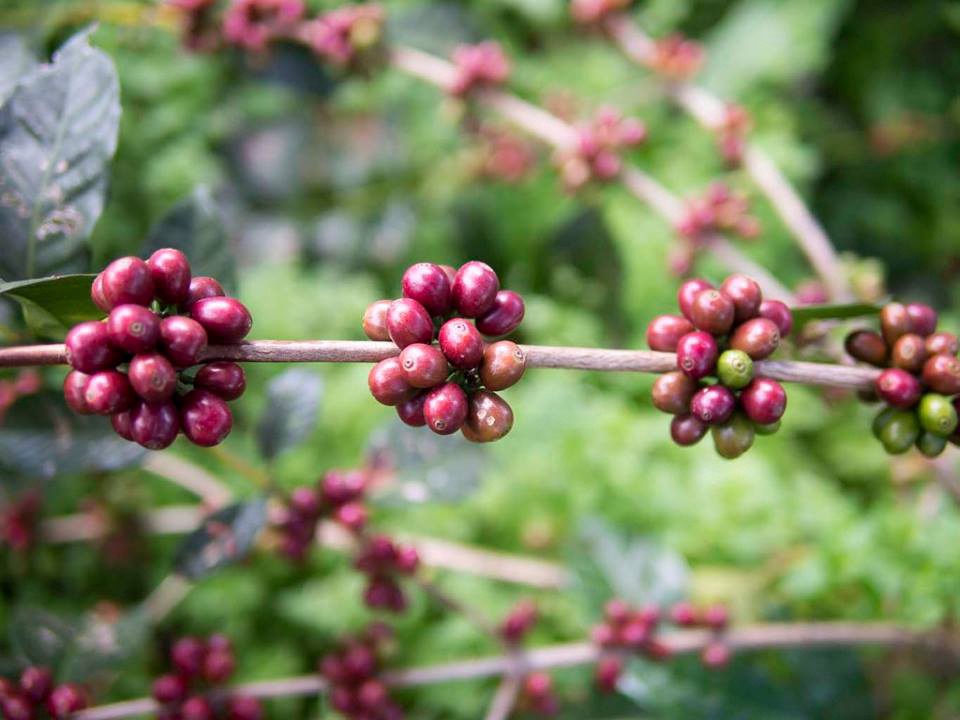About honey treatment
There are three main ways to treat coffee: sun exposure, water washing and honey treatment. The sun drying method is to directly expose the coffee cherries before removing the shell and pectin layer; the water washing method is to screen the coffee pulp before exposure and ferment to remove the pectin layer; the honey treatment method is different from the sun drying method and water washing method: after the coffee pulp is screened, the pectin layer is directly retained and exposed.
Then you will ask where is Mi?
The word honey treatment makes many people think that coffee is treated with honey, or that coffee tastes as sweet as honey, but in fact it is not either of these two explanations. The meaning of honey treatment comes from the sticky pectin layer of coffee beans before exposure, which feels as sticky as honey. when the coffee pulp is separated from the coffee beans, the outer coated pectin layer is exposed, absorbing moisture in the air and making the pectin layer sticky.
When the coffee is screened, the pectin layer will remain on the outside of the coffee bean.
Why is honey treatment popular with coffee farmers?
At the beginning of honey treatment, some people saw that this treatment could continuously improve the quality of their coffee beans, and it originated in Costa Rica, and this treatment is now ramming.
So why did Costa Rican coffee farmers plan to treat it with honey in the first place? When coffee farmers want to improve the quality or price of their coffee, they have three choices: change the species of coffee, change the altitude of planting, and change the method of treatment. Just like most people who brew coffee, they will want to use relatively simple ways, such as adjusting the grinding scale and the amount of powder, and then adjusting the amount of water, pressure and temperature of the coffee machine. Most coffee farmers also want to change the treatment method first. Then they will consider planting new tree species or moving the manor, which requires investment of time and money.
Honey treatment is time-consuming and the construction method is exquisite.
Honey treatment is not simple, it takes a long time and must be handled carefully. What are the steps involved in honey processing?
First of all, coffee farmers should select ripe coffee cherries from the coffee tree, and then screen out the outer pulp, as mentioned earlier to retain the pectin layer outside the coffee beans. The pectin layer retains a high proportion of sugar and acid, which are the key to honey treatment.
The following steps are the most complex and exquisite part of honey treatment: exposure. The time must be mastered well, and the length of time is the key. If the exposure time is too short, it is impossible to convert the substance of the pectin layer into the coffee beans, and the time cannot be too long, and the action must be fast to avoid mildew beans caused by internal fermentation.
So how do we strike a balance? Put the beans on the sun scaffolding or cement floor and turn the beans several times per hour for the first few days until they reach the desired moisture content, a step that usually takes 6-10 hours. You need to turn it at least once a day for the next 6-8 days. It takes a lot of time, huh? The reason why honey treatment is so time-consuming is that beans absorb moisture from the air every night, so that it takes more time to expose themselves the next day.
When the coffee is exposed, it is almost as dry and roasted as any other treatment.
Honey-treated coffee is being exposed on the cement floor.
Why is honey treatment so beautiful?
When honey treatment is so difficult and time-consuming, you may wonder if it's really worth it.
There's no doubt it's worth it.
Honey-treated coffee generally has a great balance of sweetness and acidity, and the flavor is generally not as strong as the coffee in the sun, but it is more fresh and mellow, so why not?
The key to this flavor difference comes from the sugar and acid quality of the pectin layer. during exposure, the sugar in the pectin layer becomes more and more concentrated, and these sugars soak into the coffee beans.
Yellow honey, red honey, black honey treatment, where is the difference?
When you want to buy honey-treated coffee, you usually have the choice of yellow honey, red honey and black honey. You may have heard of the percentage of pectin layer retained by these honey treatments, and what exactly does this mean?
Coffee farmers will classify coffee, some will retain less pectin layer so that they can be exposed faster, while others will retain more pectin layer and require longer exposure time. Yellow honey (about 25% of the pectin layer) in order to finish faster during exposure, it must be carried out in the least shaded environment (clouds, shade trees) to get a yellow appearance. Red honey (which retains about 50% of the pectin layer) takes longer and needs some shelter to expose itself. Black honey (which retains about 100% of the pectin layer) is usually covered in order to extend the exposure time.
Coffee is treated with yellow honey, red honey and black honey (from left to right)
Which is better, yellow honey, red honey or black honey?
It may be that black honey is better, the flavor of honey treatment will bring more fine and deep influence because of the residual sugar in pectin layer, and the more residual pectin layer, the stronger the flavor. (this is the view of the author of this article. Coffee seedlings think that each treatment has its own flavor, which varies from person to person. )
However, for coffee producers, they have to face another commercial consideration. Although the benefits of black honey treatment are that better quality and better price coffee can be produced, the risks and costs will also be greatly increased, so that it may affect farmers' willingness to use black honey treatment. The longer the coffee is exposed to the sun, the more likely it is to breed bacteria during fermentation, resulting in defective moldy beans. The beans need to be flipped more frequently and take up more exposure space, up to twice as much as yellow honey treatment. Not only to make high-quality coffee, but also to let coffee farmers produce the most profitable coffee. For more professional coffee exchanges, please scan the code and follow Wechat: FrontStreetCoffee

Important Notice :
前街咖啡 FrontStreet Coffee has moved to new addredd:
FrontStreet Coffee Address: 315,Donghua East Road,GuangZhou
Tel:020 38364473
- Prev

Interview: how long does a barista need to learn how to become a barista? what conditions do you need to learn how to be a barista?
Professional coffee knowledge exchange more coffee bean information please follow the coffee workshop (Wechat official account cafe_style) Bai only: how to get in touch with coffee? Have you always been interested? Or try it after opening a store? Ivy: I used to read advertising. I was interested in design, but I was very hard and busy. At that time, I had to work part-time and study, and I often had to find a place to do my homework. The big circumference is upper.
- Next

A recipe course for summer cold drinks in cafes, a complete collection of cold drinks with the best appearance.
Professional coffee knowledge exchange more coffee bean information please pay attention to the coffee workshop (Wechat official account cafe_style) coffee shop summer quick cold drink, the peak appearance of the work, the practice is super simple! Pink coconut peach bubble water Pink coconut peach saprkling water peach how delicious, if you can, eat a hundred a day should not be bored, pink coconut water
Related
- What is the meaning of lactic acid fermentation with coffee bean treatment?
- How to judge the state of foam by sound?
- How does the latte pull out the unicorn pattern? Come to get for a little trick to improve the flower pull!
- Will flower pulling affect the taste of the latte?
- Do you know the history of coffee?
- The difference between honey treatment and sun washing what is raisin honey treatment?
- What kind of milk can a novice use to make coffee foam to keep the foam longer? The correct method and skills of milking tutorial sharing
- Why do washed coffee beans taste sour? Flavor characteristics of washed Coffee
- Introduction to the skill of how to practice the size and height of water injection around the circle of hand-brewed coffee
- How do beginners practice coffee flower drawing from scratch?

